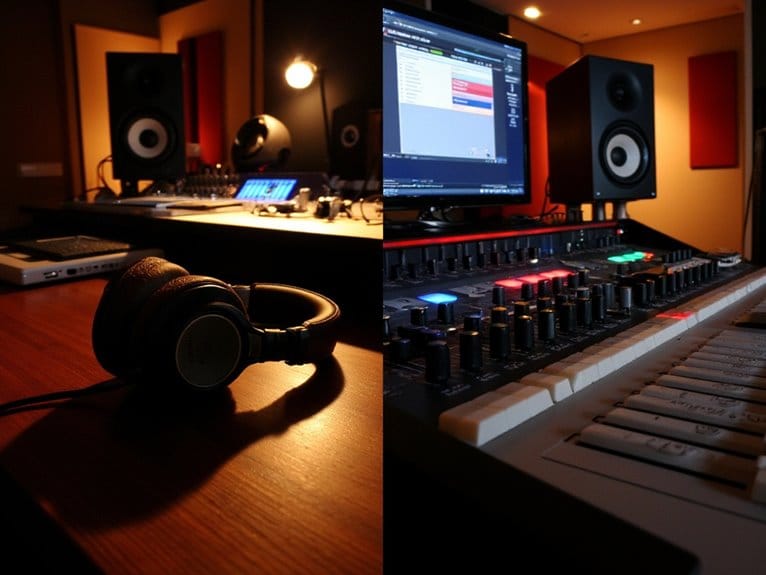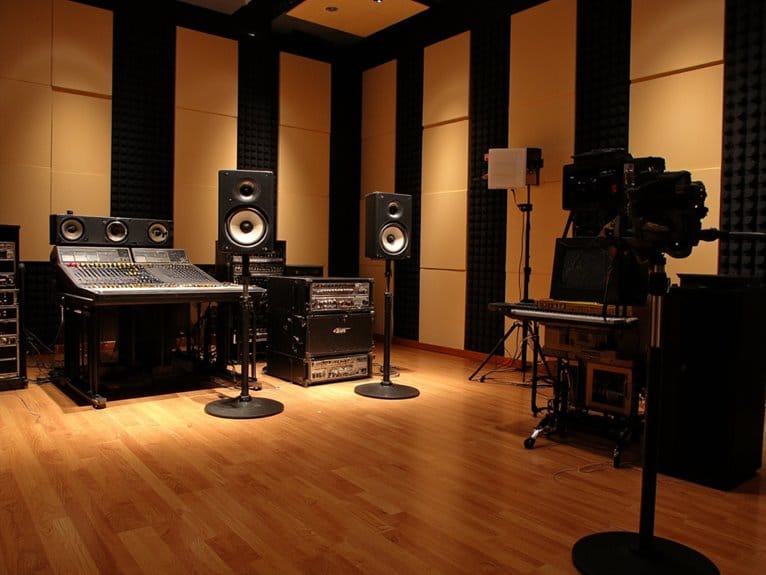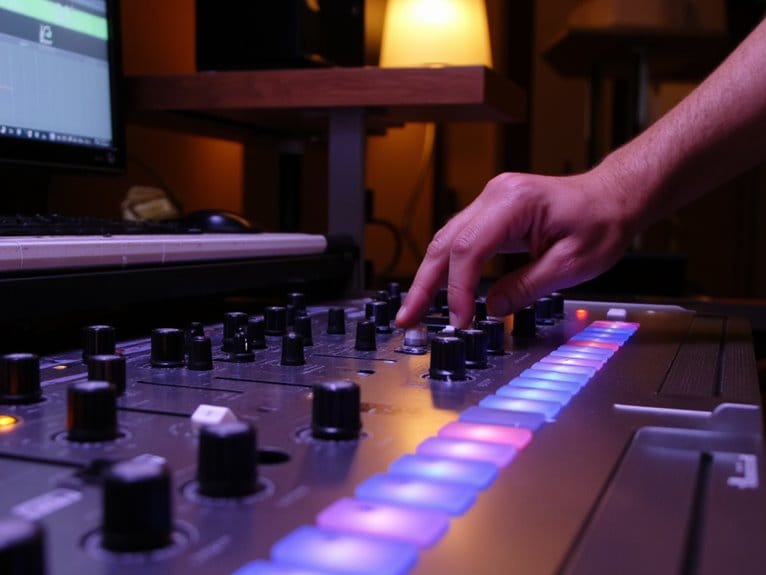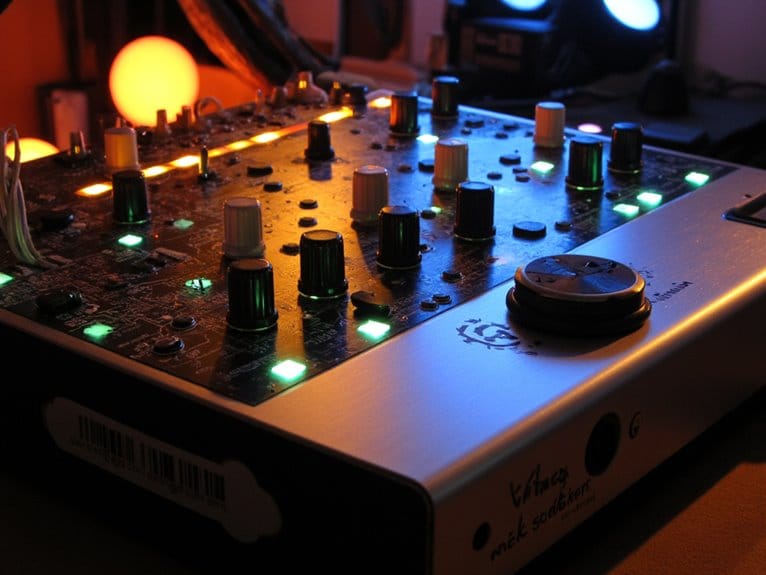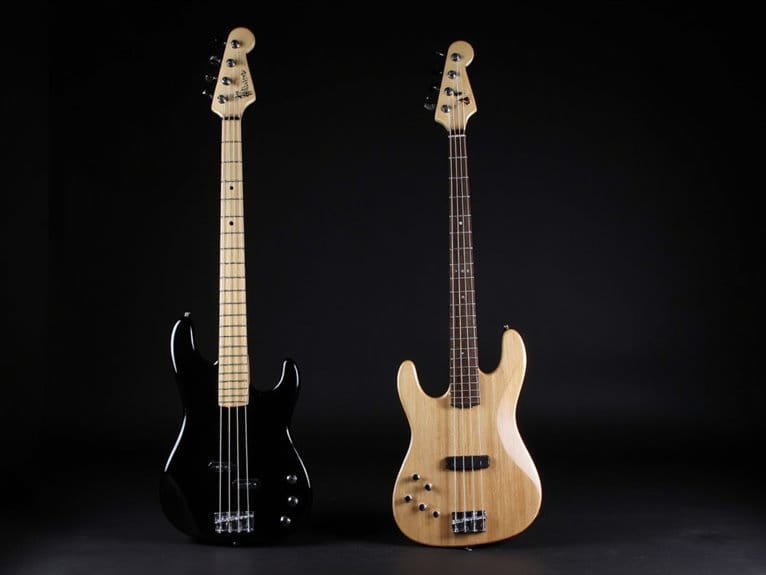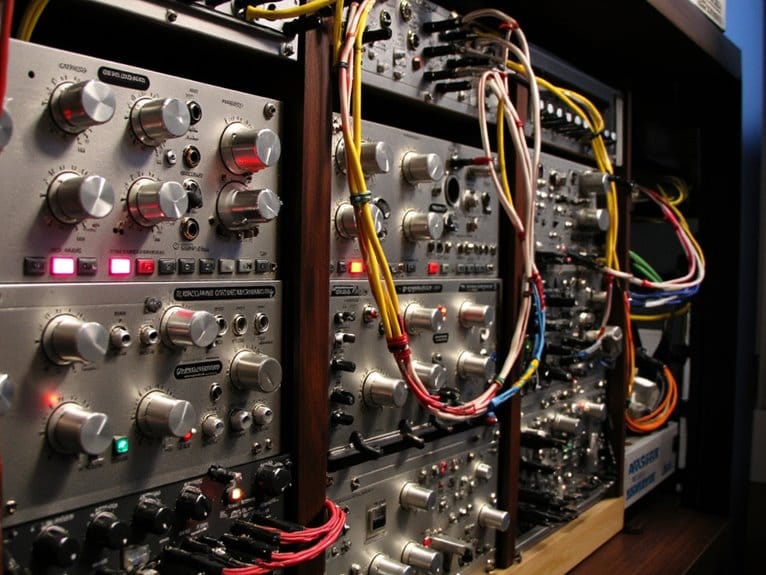When to Use Headphones Vs Studio Monitors for Mixing
You’ll want studio monitors for accurate stereo imaging and spatial decisions, since they provide natural crosstalk between channels that headphones can’t replicate. Headphones excel for detail work, late-night mixing sessions, and catching subtle elements your room’s acoustics might mask. Studio monitors encourage safer listening levels and translate better to real-world playback systems, while headphones offer convenience and isolation. The smartest approach combines both tools strategically throughout your mixing process, and understanding their specific strengths will transform your workflow.
We are supported by our audience. When you purchase through links on our site, we may earn an affiliate commission, at no extra cost for you. Learn more.
Notable Insights
- Use studio monitors when your room has proper acoustic treatment to avoid reflections and achieve accurate frequency response for mix decisions.
- Choose headphones for detailed editing work, sound isolation in shared spaces, or when mixing in untreated acoustic environments.
- Studio monitors provide natural stereo imaging with crosstalk, ensuring better mix translation to real-world speaker playback systems.
- Headphones excel at revealing subtle details and frequency conflicts but can create exaggerated stereo width and misleading spatial perception.
- Alternate between both tools regularly to cross-reference mix decisions, prevent ear fatigue, and ensure translation across diverse playback systems.
Acoustic Environment and Room Treatment Considerations
When I first started mixing in my bedroom studio, I quickly discovered that choosing between headphones and studio monitors isn’t just about personal preference-it’s fundamentally about understanding how your acoustic environment shapes what you’re actually hearing.
Your mixing decisions are only as good as what you’re actually hearing in your acoustic environment.
Your room dimensions directly influence how sound waves behave, creating problematic reflections that can sabotage your mix decisions. Hard surfaces like walls, floors, and ceilings create flutter echoes and comb filtering, while untreated corners allow bass frequencies to build up unnaturally. Even ratios between room dimensions can create particularly unpleasant audio experiences that compromise your mixing accuracy.
Studio monitors depend entirely on room acoustics since sound interacts with your environment before reaching your ears, making acoustic materials like absorption panels and bass traps essential for accurate monitoring. Creating an equilateral triangle between your monitors and listening position optimizes speaker placement for the most accurate sound reproduction.
Headphones bypass these issues completely, offering isolated listening that’s unaffected by your room’s acoustic shortcomings. Professional headphones like the Sony MDR7506 provide flat frequency response that ensures accurate sound reproduction without environmental interference.
Stereo Imaging and Spatial Perception Differences
Understanding stereo imaging differences between headphones and monitors fundamentally changed how I approach spatial decisions in my mixes, because each method delivers sound to your ears in completely different ways that affect how you perceive width, depth, and instrument placement.
Studio monitors create natural crosstalk between channels, allowing sound waves to reach both ears with realistic time and intensity differences that your brain processes as three-dimensional space. This interaction produces accurate spatial perception that translates well to real-world listening environments.
Headphones, however, isolate each channel completely, creating exaggerated stereo width that can mislead you into making overly wide panning decisions. Without crosstalk, you’ll miss the natural blending that occurs in actual rooms, potentially resulting in mixes that sound disconnected when played back on speakers.
Frequency Response and Mix Accuracy
When you’re evaluating headphones versus studio monitors for mixing accuracy, the fundamental difference lies in how each delivers frequency response to your ears, with monitors pushing sound through air while headphones create a sealed acoustic environment that bypasses room interference entirely.
You’ll find that headphones often reveal subtle frequency details and artifacts more clearly, but they frequently suffer from artificial bass boosts or treble emphasis that can mislead your mix decisions, whereas monitors provide a more natural frequency balance that translates better to real-world listening scenarios.
The challenge becomes choosing between the consistent, detailed frequency response that headphones offer versus the realistic, physically resonant sound that quality monitors deliver when paired with proper acoustic treatment.
Professional mixing headphones require a flat frequency response across the critical 20Hz-20kHz range to prevent coloration that could compromise how your mix translates across different playback systems.
High sensitivity ratings around 110 dB are crucial for detecting quiet elements in your mix that might otherwise go unnoticed during the mixing process.
Flat Response Benefits
The most critical advantage I’ve discovered in my years of audio engineering is that studio monitors deliver a flat frequency response, which means they reproduce all frequencies at equal volume levels without boosting or cutting specific bands like bass or treble.
These flat frequency response benefits prevent misleading audio coloration that can trick you into making compensatory EQ adjustments, ultimately degrading how your mix translates across different playback systems.
The mixing accuracy enhancement comes from your ability to identify frequency conflicts and masking issues that colored speakers might conceal, giving you a reliable baseline for critical listening decisions.
This uncolored representation guarantees you’re hearing exactly what’s in your mix, not what the speakers think sounds good.
Headphone Frequency Coloration
While studio monitors excel at delivering uncolored sound, headphones present a completely different challenge that I’ve wrestled with throughout my mixing career – they’re notorious for introducing frequency coloration that can mislead your ears and sabotage your mix decisions.
This frequency distortion manifests primarily in the low-frequency range, where some models boost bass excessively while others reduce it dramatically, creating a false perception of your mix’s actual balance.
I’ve learned that headphone resonance, particularly in closed-back designs, causes pressure buildup in earcups that affects perceived frequency response, especially around bass and kick drum elements.
These colorations force you into poor mixing decisions, often requiring constant cross-referencing with other playback systems to confirm what you’re actually hearing.
Detail Vs Balance
Despite headphones’ superior ability to reveal minute details in your mix, I’ve discovered they fundamentally compromise the balanced frequency response that’s essential for making accurate mixing decisions across the entire audible spectrum.
While headphones excel at detail resolution, exposing subtle distortions and background elements that monitors might miss, their isolated channel delivery creates an artificial stereo field that distorts your perception of natural instrument placement and mix width.
Studio monitors provide the balance alignment you need for frequency accuracy, allowing sound waves to interact with both ears simultaneously through natural crosstalk, which creates realistic spatial cues that translate better across playback systems.
I’ve learned that monitors’ flatter frequency response, combined with their ability to reproduce low frequencies with physical resonance, gives you the foundation for making mix decisions that work everywhere.
Mix Translation Across Playback Systems
You’ve crafted what sounds like a perfect mix on your studio setup, but here’s the reality check that’ll humble every producer: your masterpiece needs to sound equally impressive whether it’s pumping through a nightclub’s massive sound system, whispers through someone’s cheap earbuds on the subway, or fills a living room via a smartphone speaker.
The difference between headphones and studio monitors becomes critically important when you’re testing how your mix translates across these wildly different playback environments, since each system reveals unique strengths and weaknesses in your audio decisions.
I’ve learned the hard way that a mix sounding flawless on expensive monitors doesn’t guarantee it’ll maintain that clarity and balance when your audience experiences it through their preferred listening device, which is why smart producers develop systematic approaches to cross-platform validation.
Professional mixing often requires testing across different frequency response ranges, as standard consumer headphones typically cover 20 Hz to 20,000 Hz while high-end studio equipment can extend up to 40 kHz for enhanced dynamic richness.
Speaker System Compatibility
When it comes to creating mixes that sound consistent across different playbook systems, the choice between headphones and studio monitors becomes critical since each offers distinct advantages and limitations that directly impact how your mix translates to real-world listening environments.
Studio monitors excel at speaker compatibility testing because they naturally simulate how your audience will experience your music through speakers, whether that’s car stereos, home systems, or club sound systems. When you’re working with proper monitor pairing in a treated room, you’ll catch frequency imbalances and stereo imaging issues that headphones might mask.
However, headphones provide invaluable detail for spotting mix problems that speakers could miss due to room acoustics, making them essential for catching subtle artifacts and ensuring your low-end translates properly across both headphone and speaker playback scenarios.
Consumer Device Testing
Once you’ve established proper monitoring compatibility in your workspace, the real test begins when your carefully crafted mix encounters the wild west of consumer playback devices, where everything from cheap earbuds to car stereos will reveal whether your track truly holds up across the diverse listening landscape.
Understanding consumer habits and audio preferences means acknowledging that most listeners won’t experience your mix through pristine studio monitors. They’ll hear it through compressed Bluetooth speakers, smartphone drivers, or those free earbuds that came with their phone.
I’ve learned that neutral monitoring provides the foundation, but testing across multiple consumer devices exposes practical weaknesses like inaudible kick drums or harsh frequencies that sound fine on studio headphones but become grating through tiny laptop speakers.
Cross-Platform Mix Validation
How often do we get caught in the trap of perfecting a mix on our primary monitoring setup, only to discover it falls apart the moment we play it through a friend’s car stereo or smartphone speaker? This reality highlights why cross-platform mix validation isn’t optional-it’s crucial for achieving playback versatility that translates across diverse systems.
| Monitoring Method | Strength | Limitation |
|---|---|---|
| Studio Monitors | Natural stereo imaging | Room acoustics influence |
| Headphones | Isolated detail detection | Distorted spatial cues |
Effective mix preparation requires alternating between both monitoring methods during your workflow, leveraging their complementary perspectives to catch translation issues early. I’ve learned that combining frequency analyzers with resonance suppression tools helps guarantee your mix maintains proper balance whether it’s played through high-end monitors or budget earbuds.
Privacy, Convenience, and Practical Factors
Beyond the pure technical aspects of frequency response and soundstage, I’ve found that several practical considerations can make or break your mixing setup, regardless of how pristine your gear might be.
Headphones deliver complete sound isolation, letting you work late nights without disturbing roommates or neighbors, while studio monitors openly broadcast your sessions throughout the room. This isolation factor considerably impacts your workflow efficiency, especially in shared living situations or when handling unreleased material that requires confidentiality.
I’ve discovered that headphones eliminate the need for acoustically treated spaces, making them incredibly convenient for home studios or temporary setups.
You can mix anywhere, anytime, without worrying about room reflections or positioning speakers correctly, whereas monitors demand proper placement and often expensive acoustic treatment to perform accurately.
Quality mixing headphones with closed-back designs can achieve up to 85% ambient sound reduction, providing the controlled environment necessary for detailed audio work without external distractions.
Frequently Asked Questions
How Often Should I Switch Between Headphones and Monitors During Mixing?
You should switch every 15-30 minutes to maintain headphone comfort and prevent ear fatigue while leveraging monitor accuracy for overall balance. This rotation helps you catch mix issues and guarantees better translation across different playback systems.
Do Wireless Headphones Work Well for Professional Mixing Applications?
You shouldn’t rely on wireless headphones for critical professional mixing due to latency issues and reduced wireless fidelity. They’re useful for mobility during tracking, but wired options provide better mixing accuracy for precise decisions.
On a final note
You’ll get the best mixing results by using both headphones and studio monitors strategically throughout your process. Start with monitors for overall balance and stereo imaging, then switch to headphones for detail work and problem-solving. Always reference your mix on multiple systems, including consumer speakers and earbuds, to guarantee it translates well everywhere. Trust your ears, know your tools’ limitations, and you’ll create mixes that sound great anywhere.

